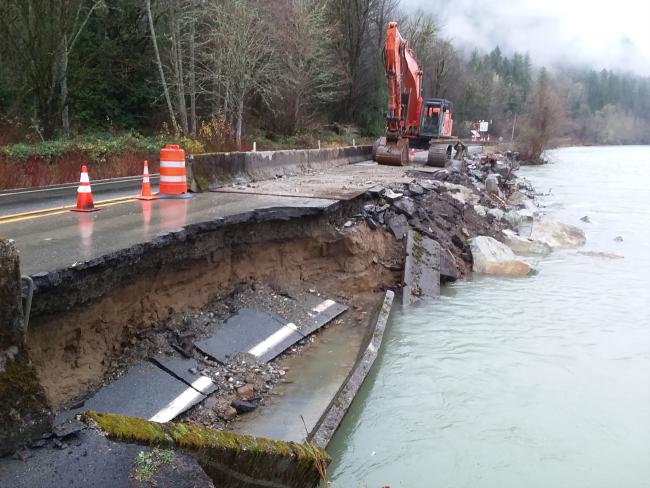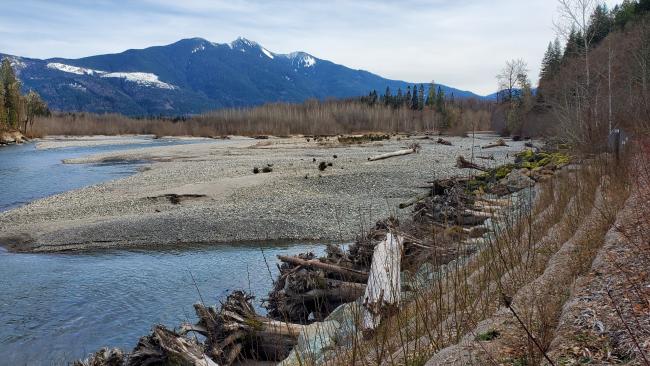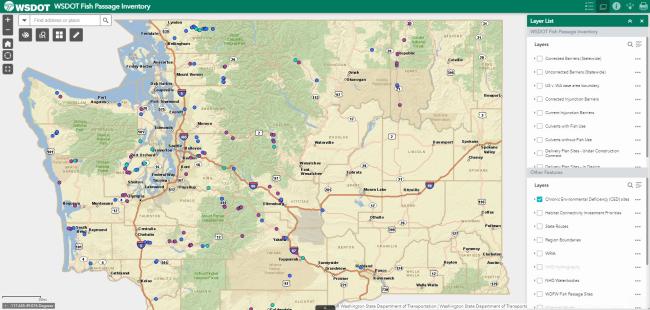Chronic Environmental Deficiencies (CEDs)
Learn how our CED program is constructing climate-resilient, nature-based retrofits that protect our highways from debris-flows and floods, improve fish habitat and reduce the need for repeat repairs.
During large storms, highways next to rivers and shorelines are vulnerable to erosion, sedimentation, flooding and washouts, which can result in frequent expensive repairs or maintenance. This can threaten safety, result in road closures, and repeatedly pull limited resources away from other emergency needs.
The frequent repairs needed to keep the highway operating can also harm fish. Sites like these on Washington’s state highways have a special status called a Chronic Environmental Deficiency (CED). A CED is a stream-adjacent location along a state highway where recent, frequent emergency repairs or maintenance to WSDOT infrastructure cause adverse impacts to fish habitat.
View our CED Annual Report (PDF 8.4MB) to learn in-depth about the CED Program, priorities and accomplishments.

Our commitment to construct fish-friendly highway protection projects
Constructing repairs along rivers, especially during high flows and emergency conditions, can damage fish habitat in several ways. Using large rock to protect streambanks simplifies habitat, disconnects rivers from floodplains and prevents growth of riparian plants. Dredging stream channels can damage fragile stream banks, remove spawning gravels and directly harm fish.
These activities require a hydraulic permit from Washington Department of Fish and Wildlife (WDFW) that can also require expensive mitigation to address these impacts. To address this problem, in 2002 we signed a Memorandum of Agreement (MOA) (PDF 1.1MB) with WDFW, in which we agreed to identify these chronic repair sites and construct long-term, nature-based retrofits that protect the highway and reduce impacts to fish from these activities.
CED projects require more technical knowledge, planning, funds and permitting than is available in a standard maintenance repair. The MOA established a collaborative process with WDFW for evaluating, scoping, funding, and delivering CED projects that allows us to continue maintaining these sites without additional mitigation until a long-term solution can be funded and constructed.
CED projects work with watershed processes
CED projects use techniques and structures that mimic natural processes and improve fish habitat, such as:
- Large wood structures that protect streambanks, increase bank complexity and redirect stream flows.
- Bioengineering to rebuild, stabilize and strengthen streambanks with riparian plants.
- Reconnecting floodplains and side channels to distribute stream flows over a larger area.
- New bridges or culverts sized to allow the stream to deposit sediment and adjust laterally and vertically.
- Relocating roadways out of the floodplain.
Learn about ways we incorporate large wood and bioengineering in CED bank protection projects in our WSDOT Hydraulics (PDF 4.7MB) and WSDOT Roadside (PDF 3.1MB) Manuals.

Status and location of CEDs
We have constructed more than 57 fish-friendly CED highway protection projects near rivers and streams. These projects use methods that work with watershed processes to protect state highways from erosion and flooding, improve fish habitat and prevent the need for future repairs and maintenance.
CEDs are categorized as active, stable or resolved. Currently there are 63 active CED sites. They are ranked for assessment and construction in our CED Priority List based on the following criteria:
- Relative fish benefit.
- Risk to infrastructure and highway safety.
- Maintenance burden.
- Partnership opportunities or conservation interest.
View information about all sites that have been nominated to the CED program in our interactive webmap.

Tips for using the webmap:
- Click the CED sites checkbox in the right-hand column to view the CED layer. Uncheck the Corrected barriers checkbox for a cleaner view. The markers are color coded by CED site status (constructed, stabilized, active).
- Click on each site marker to learn about the location, problem, and status of each CED site.
- Turn different layers on and off to view streams, waterbodies, boundaries, and fish passage inventory data. Some layers display only when zoomed in.
How we address CEDs
CED projects benefit from an extra level of technical analysis and coordination that result in targeted, innovative solutions to complicated environmental problems. At every CED site, a hydrologist conducts a technical study called a Site and Reach Assessment. The study identifies the specific watershed and site-scale causes of flooding and erosion, and then evaluates several feasible alternatives to address the problem. We then get agreement from WDFW staff on a preferred alternative prior to beginning to scope or request funds for project implementation.
The CED process described in the MOA is implemented by the CED Coordinator, who oversees the inventory, assessment, scoping and prioritization of CED projects and coordination with WDFW. This process includes four general steps:
- Nomination and analysis.
- Concept selection and stakeholder coordination.
- Project funding and implementation.
- Post-project monitoring.
View the WSDOT Environmental Manual (PDF 329KB) to learn more about how we implement this process and who is involved.
Funding CED projects
Each biennium, our legislature approves dedicated transportation improvement funds to construct CED projects. Since 2005, we have invested more than $94M for designing and constructing CED projects. When feasible, we also address CEDs as part of fish passage projects, transportation projects, and sometimes as an emergency or maintenance repair.
Our CED work contributes to other important statewide goals, including those related to climate resiliency, floodplain management, and habitat restoration. This allows us to leverage CED funds to participate in partnerships with other organizations or supplement these funds with grants. The additional analysis and collaboration built in to our CED process facilitates this participation, builds trust in WSDOT’s environmental stewardship, results in better projects, and reduces costs.
Learn how constructing CED projects helps us achieve our statewide hazard mitigation goals in the Washington State Enhanced Hazard Mitigation Plan.
Learn more about the CED program
- Learn more about the CED program, priorities, and accomplishments in the CED Annual Report (PDF 8.4MB).
- Use our interactive webmap to explore individual CED sites.
- The Memorandum of Agreement (PDF 1.1MB) between WDFW and WSDOT details our CED commitment to WDFW and describes the interagency CED concurrence process.
- The WSDOT Environmental Manual (PDF 329KB) describes our CED project delivery process, roles and responsibilities.
- Learn about ways we incorporate large wood and bioengineering in CED bank protection projects in our WSDOT Hydraulics (PDF 4.7MB) and WSDOT Roadside (PDF 3.1MB) Manuals.
Slow down – lives are on the line.
In 2023, speeding continued to be a top reason for work zone crashes.
Even one life lost is too many.
Fatal work zone crashes doubled in 2023 - Washington had 10 fatal work zone crashes on state roads.
It's in EVERYONE’S best interest.
95% of people hurt in work zones are drivers, their passengers or passing pedestrians, not just our road crews.
